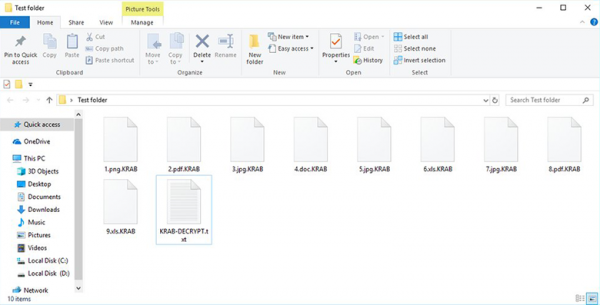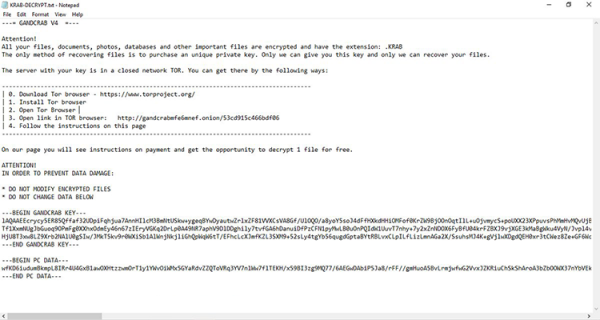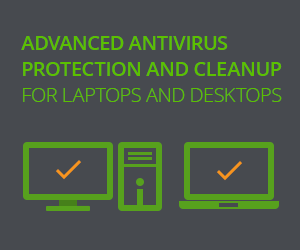Ransomware lineages come and go, but the one called GandCrab stays. Indeed, there are very few ransom Trojan species that survived the plummeting that began in late 2017. The above-mentioned strain, though, appears to be thriving and evolving regardless. Its latest variant is an upshot of several conspicuous changes made by the extortionist crew in charge. First of all, it has switched to using the .KRAB extension for encrypted data objects. As before, the actual filename remains unaltered, so a sample file 1.png transforms into 1.png.KRAB. One more modification is that the ransom note it drops is named KRAB-DECRYPT.txt.
The .KRAB edition of GandCrab ransomware is distributed in several ways, including a brand new vector that wasn’t the case previously. Malicious spam continues to be a major source of the contagion, though. The perpetrators have been deploying malspam campaigns that deliver booby-trapped emails to thousands of users. These messages contain trojanized attachments mostly disguised as invoices. Once a recipient opens the embedded file – typically a Word document – the tricky macros technique comes into play. Since the contents of the attachment aren’t properly rendered, the would-be victim is prompted to enable macros to view the information. This being done, a surreptitious script triggered behind the user’s back downloads the ransomware in no time.
A fresh payload execution mechanism used by GandCrab v4 authors involves toxic software cracks. While looking for a way to activate some popular application without paying for its license, people may lose vigilance and end up downloading a crack tool that goes bundled with the blackmail virus. These tricky downloads tend to be hosted on rogue software portals set up by the ransomware peddlers.
When up and running inside a host computer, the .KRAB files virus traverses the data repositories for potentially valuable files. It looks inside the hard drive, removable drives if any, as well as network shares. When performing the scan, the pest items that match a predefined set of common data formats, focusing on personal documents, pictures, videos, databases while skipping executables whose obliteration may lead to system errors. Next, GandCrab v4 encrypts the spotted files using a cryptosystem called the Salsa20 stream cipher. Again, every such file gets the new .KRAB extension concatenated to it.
As soon as the victim’s important information becomes inaccessible, the culprit drops a ransom note named KRAB-DECRYPT.txt. It says,
“Attention! All your files, documents, photos, databases and other important files are encrypted and have the extension: .KRAB. The only method of recovering files is to purchase a unique private key. Only we can give you this key and only we can recover your files.”
The how-to document also provides a link that the victim is instructed to open in Tor browser. It leads to a payment page that demands a ransom in either Dash or Bitcoin. The amount reportedly varies, but it’s usually somewhere between $800 and $1,200 worth of the cryptocurrency. In case the victim doesn’t cough up the extorted sum within three days, it automatically becomes twice as big as the original size. Even if the payment is made, though, it’s likely that the attackers won’t follow through on their promises, therefore those infected should try all alternative recovery techniques first. See below for details.
Automatic removal of .KRAB files ransomware
The benefits of using the automatic security suite to get rid of this infection are obvious: it scans the entire system and detects all potential fragments of the virus, so you are a few mouse clicks away from a complete fix.
- Download and install recommended malware security suite
- Select Start Computer Scan feature and wait until the utility comes up with the scan report. Proceed by clicking on the Fix Threats button, which will trigger a thorough removal process to address all the malware issues compromising your computer and your privacy.
Restore .KRAB files locked by GandCrab v4 virus
GandCrab v4 represents a unique category of malicious software whose attack surface reaches beyond the operating system and its components, which is why removing the virus itself is a part of the fix only. As it has been mentioned, it encrypts one’s personal information, so the next phase of the overall remediation presupposes reinstating the files that will otherwise remain inaccessible.
-
Launch data recovery software
Similarly to the rest of its fellow-infections, the .KRAB file virus most likely follows an operational algorithm where it erases the original versions of the victim’s files and actually encrypts their copies. This peculiarity might make your day, because forensics-focused applications like Data Recovery Pro are capable of restoring the information that has been removed. As the virus further evolves, its modus operandi may be altered – in the meanwhile, go ahead and try this.
-
Take advantage of Volume Shadow Copy Service
This technique is based on using the native backup functionality that’s shipped with Windows operating system. Also referred to as Volume Snapshot Service (VSS), this feature makes regular backups of the user’s files and keeps their most recent versions as long as System Restore is on. GandCrab v4 hasn’t been found to affect these copies therefore the restoration vector in question is strongly recommended. The two sub-sections below highlight the automatic and manual workflow.
- a) Use Shadow Explorer
Shadow Explorer is an applet that provides an easy way of retrieving previous versions of files and folders. Its pro’s include an intuitive interface where the computer’s entire file hierarchy is displayed within one window. Just pick the hard disk volume, select the object or directory to be restored, right-click on it and choose Export. Follow the app’s prompts to get the job done.

- b) Use file properties
Essentially, what the above-mentioned Shadow Explorer tool does is it automates the process that can otherwise be performed manually via the Properties dialog for individual files. This particular approach is more cumbrous but just as effective as its software-based counterpart, so you can proceed by right-clicking on an arbitrary .KRAB file, which has been encrypted by GandCrab v4, and selecting Properties in the context menu. The tab named Previous Versions is the next thing to click – it displays available versions of the file by date of the snapshot creation. Pick the latest copy and complete the retrieval by following the prompts.

-
Data backups work wonders
Ransomware like GandCrab v4 isn’t nearly as almighty and destructive in case you run regular file backups to the cloud or external data media. The virus itself can be completely removed in a matter of minutes, and the distorted information can then be just as easily recovered from the backup. Luckily, this is a growing trend, so ransom Trojans are hopefully going to become less subversive in the near future.
Verify thoroughness of the removal
Having carried out the instructions above, add a finishing touch to the security procedure by running an additional computer scan to check for residual malware activity






